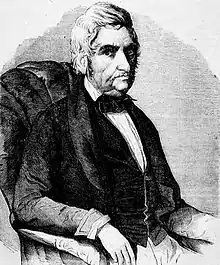Kłótnia przez zakład
Kłótnia przez zakład[1] (Polish for A Dispute over a Bet)[2] is a one-act comic opera by Karol Lipiński for a Polish libretto by Jan Nepomucen Kamiński. It was written by Lipiński at an early point of his career, when he was a resident of Lwów (now Lviv, Ukraine), and staged at the city theater before 1814.[1][2][3]

Background
Text and music
The libretto was written by Jan Nepomucen Kamiński, who was the director of the Lviv Polish theatre since 1809. It is based on a Russian comedy The Sable Fur Coat[1] (Соболья шуба, или Спорь до слез, а об закладе не бейся) by Nicolai Kugushev published in 1803.[4][5] In a handwritten text of the libretto preserved at the National Ossoliński Institute in the Polish city of Wrocław it has two different title pages with two different subtitles referring to its genre: Sceniczna fraszka and Komedyo-opera.[6]

Karol Lipiński was appointed for the post of the first violin and concertmaster at the Lemberg theater in 1810,[3] aged only 20. Two years later he was appointed its conductor. Thus it was for his own use he composed his three only operas, one of them being Kłótnia przez zakład. Around the same time he finished his three symphonies. He left Lviv[2] in 1814.[7]
The overture made use of the famous Polish national tune Jeszcze Polska nie zgineła, a fact that astonished listeners. Another piece of the opera, Starogdyrski's polonaise (Gdzież się podział...), became extremely popular[7][2] in Lviv for many years.[3]
The manuscript of the libretto and an incomplete set of orchestral parts of the opera is held at the Jagiellonian Library in Kraków.[1] Several texts for the music numbers were printed in 1815 (Rocznik Teatru Polskiego we Lwowie, 1814).[1]
Performances
The opera was definitely staged in Lviv in 1814,[2] but the first performance took place earlier.[8] It was well received by the public.[3] The role of Sowizdrzalski was played by Antoni Benza, who joined the theatre in 1811.[3][9]
A much later performance in Poznań (23 August 1838) is also known, with the original title added (Szuba sobolowa czyli Kłótnia przez zakład). The opera was also known as Szuba sobolowa lub brylantowy pierścień albo Zakład o kłótnię (The Sable Fur Coat, or, The Brilliant Ring, or, A Dispute over a Bet).[1]
Roles[10]
- Pan Wąsokrętosz
- Jego żona (his wife)
- Sowizdrzalski, ich domowy przyjaciel (their family friend)
- Gazeciarz (newsboy)
- Żyd (A Jew)
- Postylion (postman)
- Kapitan Burda (Captain Burda)
- Starogdyrski
- Panna Tryndalewiczowna
- Kupczyk (merchant boy)
References
- Kornel Michałowski (1954). Opery polskie: katalog. Polskie Wydaw. Muzyczne. p. 66.
- Xavier Jon Puslowski (9 September 2014). Franz Liszt, His Circle, and His Elusive Oratorio. Rowman & Littlefield Publishers. pp. 42–43, 49. ISBN 978-1-4422-3803-9.
- Stanisław Schnür-Pepłowski. Teatr Polski we Lwowie (1780–1881) Lwów: Gubrynowicz i Schmidt, z Drukarni "Dziennika Polskiego", 1889. pp. 72–76.
- Григорий Николаевич Геннади (1880). Справочный словарь о русских писателях и ученых умерших в XVIII и XIX столѣтиях и список русских книг: с 1725 по 1825 г. Ж-М. Том второй. pečatano v tipografii Rozentalja i Ko. p. 194.
- Собрание стихотворений, относящихся к незабвенному 1812 году. Юбилейное издание. ЛитРес. 29 March 2018. p. 629. ISBN 978-5-04-107888-1.
- Digital library entry. This libretto is also available at the IMSLP page
- Albert Sowiński [in Polish] (1857). Les musiciens polonais et slaves anciens et modernes dictionnaire biographique des compositeurs, chanteurs ... Précédé d'un résumé de l'histoire de la musique en Pologne et de la description d'anciens instruments slaves ... par Albert Sowinski. Librairie Adrien Le Clere et C.ie. p. 372.
- Despite all the sources citing the May 27, 1814, performance, this was not the first one: even in 1814 the opera was staged on some more previous occasions, the earliest performance that year being on January 21, which is not marked as a premiere. See Rocznik Teatru Polskiego we Lwowie, 1814. Unfortunately there was no such edition for the previous years.
- Also spelled Bensa (1787–1859). See a biography of him in Encyclopedia teatru Polskiego.
- The roles are given as listed in the manuscript libretto, see the IMSLP page.
External links
- Kłótnia przez zakład: Scores at the International Music Score Library Project
- Karol Łopuszański (ed.) Rocznik Teatru Polskiego we Lwowie (1814). – Contains texts for 3 musical numbers of Kłótnia przez zakład (see pp. 22–25)